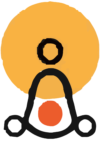Discovering the Power of Breath.
Has there ever been a moment when you noticed your breath during your work, from waking up to exercising, eating, or even when stressed? Your breath has been your constant companion. One can tell a lot about how a person is doing physically and mentally and even take a hint as to the kind of food they eat from the way one breathes. For these reasons, ancient practice comes into focus, with pranayama at the very core of the yoga routine.
How Food Affects Your Breath
According to Ayurvedic medicine, there are three different types of diets: sattvic, rajasic, and tamasic. Each of these diets affects your breathing in various ways. For instance, the sattvic diet includes fresh fruits, vegetables, and whole grains and contributes to stable, calm breathing. Conversely, the intake of stimulating foods such as coffee or sugar creates high, shallow breaths that show increased arousal within the body.
Interactive Exercise: Observe your breath the next time you eat. Is it deep and calm,or shallow and fast? These simple observations can help you better understand how different foods affect you, literally changing each response to situations in your body and mind.
The journey of Pranayama
It is not an art of controlled breathing; it is an art that should reconnect one with one’s natural breathing pattern. The journey starts just by being aware. Before learning the various techniques, one needs to watch one’s breathing throughout the day. Are you a chest breather or an abdominal breather? Do you inhale for a longer time than you exhale? These observations lay the foundation for an effective pranayama practice.
The Process Begin in a comfortable seated or lying position, preferably with your eyes closed, and start paying attention to your breath. Notice the depth. Notice the touch of the air moving in your nostrils. Notice how it’s extending your lungs. Regular practice will help you become more sensitive, thereby preparing you for advanced pranayama practices.
Controlling the Breath: The Quintessence of Pranayama
After contacting your natural breath, the next step is to start manipulating it. One of the easiest ways to do this is to slow it down. For example, if you naturally breathe in for 4 seconds and out for 4 seconds, try increasing that to 5 seconds each. That one small change will make your nervous system more relaxed and chilled, making it better focused.
Another one is yogic breathing, whereby a person breathes knowingly with the lungs’ total capacity. This requires one to breathe, taking energy from the diaphragm, chest, and even the shoulders to the maximum. This ensures the entire intake of oxygen, hence regulating the working of the lungs.
Types of Pranayama
Pranayama Type | How to Do It | Benefits |
Surya Bhedi | Inhale and exhale through the right nostril (use thumb to close the left nostril). | Energizes the body, improves digestion, and increases alertness. |
Ujjayi | Inhale deeply through both nostrils, constrict the throat, and exhale slowly while maintaining the throat constriction. | Calms the mind, increases oxygen flow, reduces stress, and promotes mental clarity. |
Sheetkari & Sheetli | Inhale through the mouth (tongue curled or teeth slightly open), exhale through the nose. | Cools the body, reduces heat-related issues, and calms the nervous system. |
Bhastrika | Forceful inhalation and exhalation through both nostrils, using the diaphragm vigorously. | Boosts energy, clears respiratory passages, increases oxygen supply, and stimulates metabolic rate. |
Pranayama in Disease Management
It is researched and proven that pranayama is an excellent therapeutic tool in the management of any health condition, which includes hypertension, diabetes, and mental disorders. For example, slow and deep breathing can lower blood pressure, and some pranayama can improve insulin sensitivity in diabetics. Apart from this, pranayama, with its soothing effect on the nervous system, proves to be of great use for the treatment of anxiety and depression.
Your Pranayama Plan: Start with 5-10 minutes of pranayama each day. Ideally, perform it in the morning on an empty stomach. After you become comfortable with a technique, feel free to change to others for experimentation and variety.
Conclusion
Pranayama is much more than controlling your breath; it is, in fact, about rediscovering your natural process of rhythm in your body and mind. With this knowledge, you will be able to use your breath powerfully as a force to engage in good health, lower levels of stress, and well-being. Take a deep breath now, and begin your journey!

